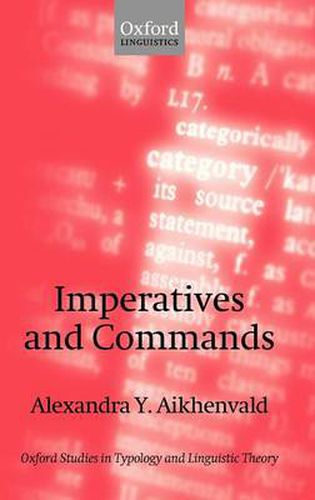Readings Newsletter
Become a Readings Member to make your shopping experience even easier.
Sign in or sign up for free!
You’re not far away from qualifying for FREE standard shipping within Australia
You’ve qualified for FREE standard shipping within Australia
The cart is loading…






This is the first cross-linguistic study of imperatives, and commands of other kinds, across the world’s languages. It makes a significant and original contribution to the understanding of their morphological, syntactic, semantic, and pragmatic characteristics. The author discusses the role imperatives and commands play in human cognition and how they are deployed in different cultures, and in doing so offers fresh insights on patterns of human interaction and communcation.Alexandra Aikhenvald examines the ways of framing commands, or command strategies, in languages that do not have special imperative forms. She analyses the grammatical and semantic properties of positive and negative imperatives and shows how these correlate with categories such as tense, information source, and politeness. She looks at the relation of command pragmatics to cultural practices, assessing, for example, the basis for Margaret Mead’s assumption that the harsher the people the more frequently they use imperatives. Professor Aikhenvald covers a wide range of language families, including many relatively neglected examples from North America, Amazonia, and New Guinea. The book is accompanied by illustrations of some conventional command signs.Written and presented with the author’s characteristic clarity, this book will be welcomed by linguists of all theoretical persuasions. It will appeal to social and cultural anthropologists and cognitive and behavioural scientists.
$9.00 standard shipping within Australia
FREE standard shipping within Australia for orders over $100.00
Express & International shipping calculated at checkout
This is the first cross-linguistic study of imperatives, and commands of other kinds, across the world’s languages. It makes a significant and original contribution to the understanding of their morphological, syntactic, semantic, and pragmatic characteristics. The author discusses the role imperatives and commands play in human cognition and how they are deployed in different cultures, and in doing so offers fresh insights on patterns of human interaction and communcation.Alexandra Aikhenvald examines the ways of framing commands, or command strategies, in languages that do not have special imperative forms. She analyses the grammatical and semantic properties of positive and negative imperatives and shows how these correlate with categories such as tense, information source, and politeness. She looks at the relation of command pragmatics to cultural practices, assessing, for example, the basis for Margaret Mead’s assumption that the harsher the people the more frequently they use imperatives. Professor Aikhenvald covers a wide range of language families, including many relatively neglected examples from North America, Amazonia, and New Guinea. The book is accompanied by illustrations of some conventional command signs.Written and presented with the author’s characteristic clarity, this book will be welcomed by linguists of all theoretical persuasions. It will appeal to social and cultural anthropologists and cognitive and behavioural scientists.